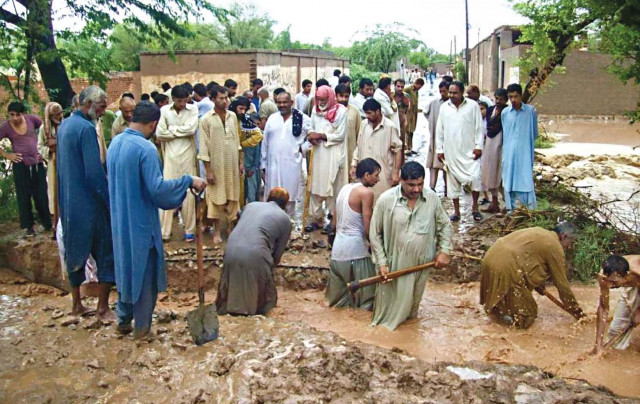Punjab is drowning…
Monsoon floods have caused havoc in the rural and urban areas of Punjab.

Local authorities in Multan have decided to evacuate the city keeping in the view rising water levels. The Multan tehsil municipal authority (TMA) officials said that they expected around 200,000 cusecs of water to pass through the city. “This is why it has become imperative that we begin evacuating people from settlements located near the river banks. They will not leave the place voluntarily so we need to coordinate with the police,” said Hussain Raza, a TMA official. The flood water is passing through Qadirabad and will reach Multan via Tremo.
In order to inspect relief measures an emergency meeting was recently called by Multan district coordination officer (DCO) Khuram Ali Agha. In which it was decided that the army would also be called in to assist with evacuation. Agha said that flood relief camps would be set up and a civil defence department would be made active. People living near the river have been warned in his regard and announcements have been made from mosques. The DCO has given strict instructions that the residents be provided temporary residence and has also sought a report the Water and Sanitation Agency (Wasa) on improving the sewerage system.
The floods also wreaked havoc in Gujranwala, Sialkot, Chiniot, Mandi Bahauddin, Guhrat, Hafizabad, Malkwal, Tnsa, Pindi Bhattian, Jalalpur Bhattian, Head Marala, Jodhanklan, Daudkhel, Grot and Wah Bichran. Thousands of acres of rice crop have been affected and in the River Chenab a low intensity flood was observed at Qadirabad.
According to Rescue 1122 sources in Qadirabad Kala Shadian, chak Abdullah, Jagu, Ratu and Malik Syeda 30 other villages were inundated and people are being evacuated in every district. A rescue spokesperson, Malik Asghar, said that people were not ready to leave behind their livestock. “It is hard to convince them to leave behind everything and relocate. They say that they don’t trust the government to compensate for their losses,” he said. Over 70 people in Grot and Mandi Bahauddin have been shifted to higher ground along with their belongings. According to a flood control cell in Qadirabad 212,806 cusecs of water is currently passing through the district and on Rasool barrage 34,700 cusecs of water has been recorded. A large quantity of flood water is expected to pass through the barrage on Saturday and Sunday.
In Mandi Bahauddin the rain lashed through the district at 4am on Friday evening and the water has already begun flooding the streets. Similarly in Malkwal, Chak Dhudian, Khewa, Kot Hust and other areas announcements have been made from mosques to warn people to evacuate their homes. In Malkwal, locals witnessed the third day of constant rain and water levels have continued to rise in Head Maral as recent levels from River Chenab were recorded at 142,638 cusecs.
In Bujwat people have issued warnings to evacuate their homes and the Benazir bridge on River Tawi has been flooded as 87 villages have lost land connection with the rest of the country. “There were still cars on the bridge when the water rose to the point that the bridge was being flooded. The police evacuated the bridge and within an hour it was no where in sight,” said an eyewitness Khurram Sial.
On Thursday, low lying areas in Gujrat were inundated after rain lashed and people had to face difficulties. In Tanda and other areas rainwater entered houses and roads in Tanda, Badela Sharif, Kakianwala, Hussain house Madi Khokhran, Khadi Sharif and Surkhpur were destroyed.
In Jalalpur Jattan areas Kot Dayam, Martha, Bhon Rata, Bhon Fazil, Mehmoodpur, Sheikh Musa, Kot Pehlwan, Mehr Mukhtar, Khitay Shah, Kot Muhabbat, Kot Ghazi, Mahi Al, Ghari Gondal, Kot Alam, Burj Phatu and dozens of other areas that have been completely drowned by the rising water. Villagers have started moving their livestock to higher ground.
In Pindi Bhattian due to passing of 240,000 cusecs of water, dozens of villages were inundated. District flood relief officer Muhammad Akram said that the district administration was ready to face the flood and measures were being taken in this regard. “The situation is in control so far and water level at Head marala and Khanki is declining,” he said, adding that under the guidance of DDO coordination Zaheer Abbas a flood control centre was operational and could be contacted at 0547-523600. He said officials had been deployed at all Tehsil and district levels and other departments were also on high alert to deal with the floods.
In Chiniot, the River Chenab is at medium flood range and the district flood control centre is actively monitoring the situation. Widespread riverine areas including more than 70 bastis, with agricultural land have been inundated. These include kot Mohammad Yr, Wara Sultan, Thattha Mohammad Shah, Kot Najabat, Karak Mohammadi, Dhari and several other areas. Officials said that due to prompt warning there was no loss of human life has been reported from the district but livestock and crops in many areas have been severely damaged and a number of houses have caved in.
Water levels in Chenab were recorded at 188,000 cusecs on Thursday and have risen to 225,500 cusecs on Friday. Authorities in Sialkot have managed to take control of the situation and according to senior officials of the Sialkot Irrigation Department, the flow of water was recorded at 127,670 cusecs at Head Marala in River Chenab near Sialkot. They said that the water level was now receding in the vicinity. The Sialkot district administration has already divided the district into 17 sectors and 34 sub sectors to combat the recurring flood threats, besides, establishing 34 flood relief camps in the area.
Published in The Express Tribune, July 31st, 2010.



















COMMENTS
Comments are moderated and generally will be posted if they are on-topic and not abusive.
For more information, please see our Comments FAQ